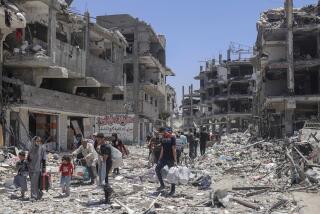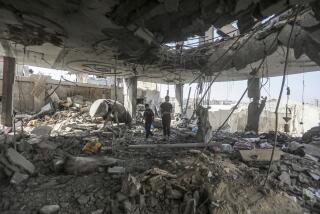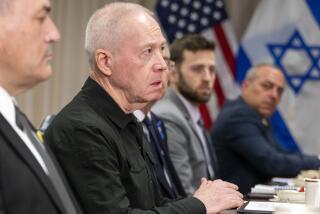Planning an Iraqi War but Not an Outcome
- Share via
WASHINGTON — Just before plans for military action against Iraq began issuing from the Bush administration last month in a shower of leaks, the Defense Intelligence Agency (DIA) produced a place-mat-size volume laying out the most up-to-date information on Saddam Hussein’s capabilities.
The classified study, “Iraq--An Operational Support Study,” is a gold mine of maps and data on geography, roads, refineries, communications facilities, security organizations and military deployments. Even after 11 years of sanctions and fairly regular U.S. bombing in the no-fly zones, the document paints an impressive picture of Iraq’s assets. Though the DIA study is not a target list, it does present a huge menu of potential targets. “The target list in Iraq is humongous, some would say egregious,” said a senior naval intelligence officer who has worked in the Saudi-based Combined Air Operations Center.
The DIA report clearly presents toppling Hussein’s regime as a challenge so formidable that only tremendous military resources could accomplish it. Not surprisingly, that analysis exactly fits the war plan emerging from Gen. Tommy Franks’ U.S. Central Command (CentCom) in Florida: The plan assumes the worst for the United States and posits a massive ground invasion by the Army’s “heavy” tank and mechanized infantry divisions.
Predictably, Franks’ proposal has sparked criticism among the other armed services. But what is at stake goes beyond traditional interservice rivalry. How a war against Iraq is fought will affect how it ends, and what the near- and long-term costs are for everyone.
The plan, some senior officials say, ignores the 21st century reality of the U.S. military and misreads what happened during the 1991 Gulf War. Those expressing reservations include some senior Defense Department officials, civilians who are not tied to any individual service. In recent days, even a senior Army officer has begun raising questions about the size of the anticipated ground force.
When a prospective Iraq war strategy first circulated within a tight circle in CentCom earlier this year, it called for a full-scale ground campaign with the goal of “regime change” in Baghdad. That was to be achieved by a combination of brute force and a hoped-for rising up of the Iraqi people and military commanders against Saddam.
The plan, which seemed not to consider America’s advantages and Baghdad’s accumulated weaknesses, struck critics as simplistic and myopic. Three of the four subordinate commands within CentCom--the Air Force, the Navy and the Marines--took the unprecedented step of expressing alarm at a CentCom meeting at Ramstein Air Base in Germany last month.
The first version of the plan emerged in February of this year when Franks and the Army commander at CentCom, Lt. Gen. Paul Mikolashek, presented a briefing during a secure video teleconference. Mikolashek is commander of the U.S. Third Army, which is currently responsible for all conventional and special operations forces on the ground in Afghanistan and would take the lead against Iraq under the Franks plan.
The plan presented by Franks and Mikolashek envisioned five divisions (some 150,000 troops) and five aircraft carriers launching simultaneous ground and air attacks into southern Iraq. According to senior officers in the initial briefings, the plan rested on two major assumptions: that the war would be predominantly an armor battle with aircraft supporting land forces; and that Saudi Arabia would not let U.S. forces use bases on its soil. Hence the plan largely excluded land-based air forces.
Launching ground and air attacks simultaneously--instead of leading off with a substantial air assault first to soften up Iraqi defenses--would produce shock and awe in enemy forces, according to early briefing documents. “It was a lead-with-your-chin, ground-only war,” a senior officer not in the Army said. But, he added, “The only shock and awe inspired was the ‘you gotta be [kidding] me’ look” it evoked in critics.
The Franks plan clearly ignored successful elements of the last three major U.S. military campaigns: Iraq in 1991, Kosovo and Afghanistan. The heart of all those engagements was exploiting “asymmetrical advantages.” That is, making maximum use of fighting capabilities in which the United States is strong and the enemy weak. In Iraq, Kosovo and Afghanistan, that meant using air power and high-tech weaponry to attack key “strategic” targets while also using bombs and ground troops to attack enemy forces directly.
As initially presented, the Iraq attack plan not only excluded initial bombing to soften Iraqi defenses; it also did not consider alternate strategies to destroy suspected weapons of mass destruction.
After the unveiling, Franks was quizzed about the practicalities: How could short-range aircraft from carriers sustain the necessary operations? How could a campaign of such magnitude be waged without land-based aerial refueling? How would persistent reconnaissance and surveillance of Iraq be provided without significant Air Force assets on the ground?
The assumption that Saudi Arabia would not allow the U.S. to use bases there was also questioned. To many officers, and to senior Defense Department officials, it is inconceivable that the White House would assault Iraq without Saudi Arabia at least acquiescing. At a minimum, that would include using Saudi bases for such support operations as aerial refueling, surveillance and air defense. What is more, some were baffled by CentCom’s disregard of air assets already on the ground in Kuwait, in Gulf states such as Qatar and Oman, in Turkey and in the Indian Ocean region.
Still, advocacy of the basic plan, with its reliance on “heavy” ground forces, has persisted. By March, Franks had been persuaded to open the campaign with an air assault. But he limited such an assault to 60 hours. AC-130 gunships and a handful of A-10s operating from Kuwait were also incorporated into the plan in order to offer close air support for ground troops, “on a very short and tight tether controlled by the Army,” a senior officer said.
As planning continued into April, the internal questioning continued too. “How can you have shock and awe and deploy such a massive ground force at the same time?” one officer asked. Though the Army has positioned tanks and armored vehicles in Kuwait and Qatar, deployment of large numbers of troops could not be kept secret and might well provoke an Iraqi response.
Officers and civilian officials also are stymied by the close relationship Franks has developed with Defense Secretary Donald H. Rumsfeld. One effect of the Rumsfeld-Franks relationship is that Air Force Gen. Richard B. Myers, chairman of the Joint Chiefs of Staff, is excluded from much discussion. And the service chiefs, ostensibly the senior military advisors for the Defense secretary and the president, have less opportunity to provide input.
In fact, sources say, the emerging Iraq plan was never officially brought into “the tank,” the Joint Chiefs’ super-secure meeting room, for a discussion among the heads of all the services.
Many uncertainties remain. One central idea of the plan, for example, is that as they work their way northward on the ground, “indigenous forces” will rise to support the invaders. But the plan’s critics wonder what will happen if they do not rise, or if they prove ineffective. Would that, a senior Defense Department official asked in raising some of the nightmarish possibilities, mean “grinding urban warfare? Attacks with chemicals or biological agents?” “If these are truly concerns, one might want to construct a war strategy to minimize those eventualities, not one that plays into them, even encourages them to emerge,” this official said.
If there’s a silver lining to the parochialism and lack of imagination in the Franks/Mikolashek plan, it is the search it has provoked for creative alternatives. “If placement of a U.S. corps in Kuwait provokes the Republican Guards to deploy to the desert and prepare the defense of Basra, I say, great, come on down,” a senior Air Force officer said, noting that then 21st century airpower could once again be employed to bomb a hapless army stuck in 20th century trenches.
Another alternative would be to use Special Forces and air power to pinpoint Iraqi military and other assets and destroy them one by one. That, some believe, could force the Iraqi army to choose between continued support for Hussein and its own survival. Faced with such a choice, Republican Guards and other army units might bring about a regime change themselves.
Under the Franks plan, there is no credible notion of how regime change occurs, making any war’s likely ultimate destination urban fighting in the Baghdad megalopolis. The final objective would be U.S. occupation.
Would occupation be such a terrible outcome? In reality, it might be the only way to guarantee removal of weapons of mass destruction and avoid a worse-than-Saddam outcome. But in the world of military planning, such an eventuality is not even conceived.
Preoccupied with divisions marching here and there--against an overrated foe--Franks and his planners do not make the connection between how the United States fights and what the outcome might be.
More to Read
Sign up for Essential California
The most important California stories and recommendations in your inbox every morning.
You may occasionally receive promotional content from the Los Angeles Times.













